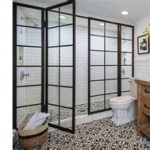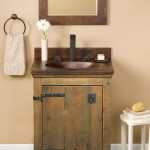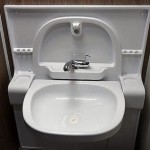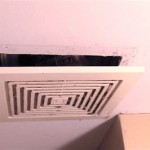Vintage Bathroom Vanity Faucets: A Timeless Elegance
Vintage bathroom vanity faucets represent more than just functional plumbing fixtures; they embody a design philosophy that values enduring style, craftsmanship, and historical context. These faucets, often characterized by intricate designs, durable materials, and distinctive finishes, offer a unique aesthetic that can transform a modern bathroom into a space imbued with character and charm. The allure of vintage faucets lies in their ability to connect the present with the past, providing a tangible link to earlier eras of design and manufacturing.
The term "vintage" typically refers to items that are at least 20 years old but not yet considered antique (generally over 100 years old). Within the realm of bathroom fixtures, this encompasses designs from the mid-20th century onward, including Art Deco, Mid-Century Modern, and even styles inspired by the Victorian and Edwardian eras. The selection of a vintage faucet involves careful consideration of style, functionality, and the overall aesthetic of the bathroom in which it will be installed. Unlike contemporary faucets that often prioritize sleek minimalism, vintage faucets often feature ornate detailing, sculpted handles, and rich, warm finishes.
The sourcing of vintage faucets can be pursued through various channels, including antique stores, estate sales, online marketplaces specializing in vintage goods, and architectural salvage yards. Each of these avenues offers a unique experience and distinct advantages. Antique stores and estate sales provide opportunities for personal inspection and negotiation, while online marketplaces offer a wider selection and potentially lower prices. Architectural salvage yards may offer unique, reclaimed fixtures that possess historical significance and substantial character.
Understanding the Appeal of Vintage Faucet Designs
One of the primary reasons individuals choose vintage bathroom vanity faucets is their distinctive design. The designs often stand in stark contrast to the minimalist lines that dominate contemporary bathroom fixtures. For instance, Art Deco faucets, popular from the 1920s to the 1940s, typically showcase geometric shapes, symmetrical patterns, and stepped details. These designs often incorporate materials such as chrome, porcelain, and Bakelite, reflecting the era's fascination with modern technology and streamlined aesthetics. The elegance of these faucets lies in their ability to blend functionality with artistic expression, making them a focal point of any bathroom.
Mid-Century Modern faucets, prevalent from the 1950s to the 1960s, often emphasize clean lines, organic forms, and a sense of functional simplicity. These faucets frequently feature sleek chrome finishes, streamlined silhouettes, and minimalist handles. Designers of this era sought to create fixtures that were both aesthetically pleasing and highly practical, reflecting the post-war emphasis on efficiency and modern living. The understated elegance of Mid-Century Modern faucets makes them a versatile choice for bathrooms with a range of architectural styles.
Another design inspiration for vintage faucets is derived from the Victorian and Edwardian periods. These styles are characterized by elaborate ornamentation, intricate detailing, and a focus on craftsmanship. Faucets inspired by these eras often feature sculpted handles, decorative spouts, and rich finishes such as brass, copper, and nickel. The use of porcelain accents and intricate engravings further enhances the historical allure of these fixtures. While these faucets may require more maintenance than their modern counterparts, their timeless elegance and unique character make them a valuable addition to any vintage-inspired bathroom.
The selection of a vintage faucet design should be aligned with the overall aesthetic of the bathroom. For a bathroom with an Art Deco theme, a faucet with geometric shapes and chrome accents would be a natural fit. For a Mid-Century Modern bathroom, a faucet with clean lines and a minimalist design would be more appropriate. In a Victorian-inspired bathroom, a faucet with ornate detailing and a rich finish would contribute to the room's historical charm. Careful consideration of the faucet's design in relation to the other elements of the bathroom is essential for creating a cohesive and visually appealing space.
Key Considerations When Selecting a Vintage Faucet
Beyond aesthetics, the selection of a vintage bathroom vanity faucet requires a thorough evaluation of several practical factors. These factors include the faucet's condition, functionality, compatibility with existing plumbing, and ease of installation. While the visual appeal of a vintage faucet may be immediately apparent, a closer examination is necessary to ensure that it is a durable and reliable choice for long-term use.
The condition of a vintage faucet is of paramount importance. Examine the faucet carefully for signs of wear and tear, such as corrosion, scratches, dents, and leaks. Check the handles and spouts for smooth operation and ensure that all moving parts are in good working order. If possible, test the faucet's water flow and pressure to verify that it is functioning properly. In some cases, minor repairs or restoration may be necessary to restore a vintage faucet to its original condition. However, if the faucet is severely damaged or corroded, it may not be a viable option. A professional plumber can be consulted to assess the faucet's condition and advise on the feasibility of repairs.
Compatibility with existing plumbing is another crucial consideration. Vintage faucets may have different connection sizes and configurations than modern faucets. Verify that the faucet's inlets and outlets are compatible with the water supply lines and drains in the bathroom. In some cases, adapters or modifications may be necessary to ensure a proper fit. It is advisable to consult with a plumber before purchasing a vintage faucet to ensure that it can be installed safely and effectively. Ignoring compatibility issues can lead to leaks, water damage, and costly repairs.
Ease of installation is also a relevant factor, particularly for individuals who plan to install the faucet themselves. Vintage faucets may require specialized tools or techniques for installation. If the installation process appears complex or challenging, it is recommended to hire a professional plumber. A professional plumber will have the expertise and equipment necessary to install the faucet correctly and ensure that it is functioning properly. Improper installation can lead to leaks, water damage, and other problems.
Furthermore, consideration should be given to water conservation. Older faucets often predate contemporary water-saving technologies. If water conservation is a priority, investigate whether the vintage faucet can be retrofitted with a low-flow aerator. These aerators can significantly reduce water consumption without compromising water pressure. Alternatively, consider selecting a more recent reproduction vintage-style faucet that incorporates water-saving features.
Maintaining and Restoring Vintage Bathroom Faucets
Once a vintage bathroom vanity faucet has been selected and installed, proper maintenance is essential for preserving its beauty and functionality. Regular cleaning, lubrication, and occasional repairs can help to extend the lifespan of the faucet and prevent costly problems. With careful attention and appropriate care, a vintage faucet can continue to provide years of reliable service.
Regular cleaning is crucial for preventing the buildup of mineral deposits, soap scum, and other contaminants. Use a soft cloth and a mild, non-abrasive cleaner to wipe down the faucet regularly. Avoid using harsh chemicals or abrasive cleaners, as these can damage the finish and corrode the metal. For stubborn stains or mineral deposits, a solution of vinegar and water can be used to gently dissolve the buildup. Rinse the faucet thoroughly with clean water after cleaning and dry it with a soft cloth.
Lubrication of moving parts is also important for maintaining smooth operation. Apply a small amount of silicone-based lubricant to the faucet handles, spouts, and other moving parts to prevent sticking and squeaking. Avoid using petroleum-based lubricants, as these can damage the faucet's finish and attract dirt and grime. Lubrication should be performed periodically, depending on the frequency of use and the environmental conditions.
Occasional repairs may be necessary to address minor issues such as leaks, drips, or loose handles. Leaks are often caused by worn-out washers or O-rings. These parts can usually be replaced easily with standard replacement parts. Loose handles can often be tightened with a screwdriver or wrench. If the repairs are beyond one's capabilities, a professional plumber should be consulted. Attempting to repair a vintage faucet without the necessary knowledge and tools can exacerbate the problem and potentially cause further damage.
In some cases, restoration may be necessary to restore a vintage faucet to its original condition. Restoration may involve stripping off old paint or finishes, polishing the metal, and replacing damaged or missing parts. Restoration is a more involved process than simple repairs and may require specialized skills and equipment. Depending on the condition of the faucet and the desired level of restoration, it may be advisable to hire a professional restorer.
The appeal of vintage bathroom vanity faucets lies not only in their aesthetic qualities but also in their enduring craftsmanship and historical significance. By understanding the design characteristics, practical considerations, and maintenance requirements of vintage faucets, individuals can select fixtures that enhance the beauty and functionality of their bathrooms for years to come. The care and attention given to these vintage pieces are a testament to their value and a celebration of timeless design.

Deco Widespread Bathroom Sink Faucet Metal Lever Handles

Juno Vintage Bathroom Faucet Antique Style Basin Mixer Tap Vessel Sink

Rers Metropolitan Widespread Lavatory Faucet Buckingham Cross Van Dyke S

Juno Classic Antique Brass Dual Handle Bathroom Sink Faucet

Vintage Style Bathroom Faucets Design Ideas

Modern Bathroom Sink Faucet Collection Vintage Tub Bath

Kingston Brass Vintage Polished Widespread 2 Handle Bathroom Sink Faucet With Drain In The Faucets Department At Com

1946 Vintage Standard Shelfback Lavatory Sink W Faucet Dea Bathroom Machineries

60 Off Antique Gold Sink Faucets Modena Widespread 8 Brass Bathroom Faucet Dual Handle Thermostatic Mixer At Fontanashowers

Vintage Bathroom Faucets Sink Fixtures Van Dyke S Rers
Related Posts







